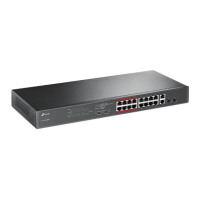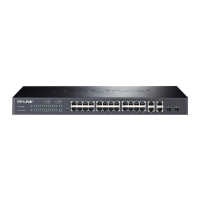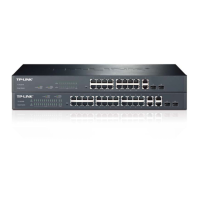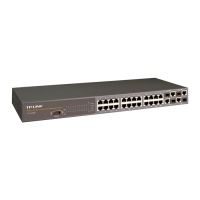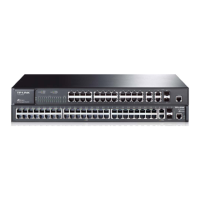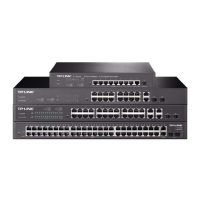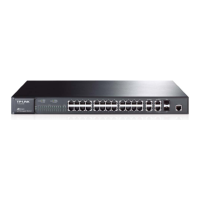Do you have a question about the TP-Link TL-SL1226P and is the answer not in the manual?
Details the TP-Link PoE+ switches, their capabilities, and standards compliance for network deployment.
Describes front panel layout, LEDs, switches, rear panel ports, and power/grounding connections.
Lists all items included in the switch package, such as the switch, power cord, and mounting hardware.
Details safety rules, site requirements, temperature/humidity, ESD, EMI, and lightning protection.
Lists the necessary tools for installing the switch, including screwdrivers and ESD-preventive wrist straps.
Provides step-by-step instructions for desktop and rack mounting the unmanaged PoE+ switch.
Explains how to connect the switch to a computer using an RJ45 Ethernet cable.
Demonstrates the procedure for connecting an SFP module to the switch's SFP port.
Lists checks for proper ventilation, power supply voltage, grounding, and network device connectivity.
Guides on connecting the power cord to the device and a power outlet for operation.
Describes the Power-On Self-Test process and LED indicator behavior during switch startup.
Troubleshoots why the PWR LED might not be lit, checking power source and voltage.
Helps diagnose why the Link/Act LED is not lit when a device is connected, checking cables and device status.
Explains why some ports may not supply PoE power due to total power consumption limits.
Details the types and quantities of RJ45 and SFP ports available on different switch models.
Outlines the PoE port configuration and total power supply capacity for each switch model.
Lists operating temperature, humidity, and power supply requirements for the switch.
Details the TP-Link PoE+ switches, their capabilities, and standards compliance for network deployment.
Describes front panel layout, LEDs, switches, rear panel ports, and power/grounding connections.
Lists all items included in the switch package, such as the switch, power cord, and mounting hardware.
Details safety rules, site requirements, temperature/humidity, ESD, EMI, and lightning protection.
Lists the necessary tools for installing the switch, including screwdrivers and ESD-preventive wrist straps.
Provides step-by-step instructions for desktop and rack mounting the unmanaged PoE+ switch.
Explains how to connect the switch to a computer using an RJ45 Ethernet cable.
Demonstrates the procedure for connecting an SFP module to the switch's SFP port.
Lists checks for proper ventilation, power supply voltage, grounding, and network device connectivity.
Guides on connecting the power cord to the device and a power outlet for operation.
Describes the Power-On Self-Test process and LED indicator behavior during switch startup.
Troubleshoots why the PWR LED might not be lit, checking power source and voltage.
Helps diagnose why the Link/Act LED is not lit when a device is connected, checking cables and device status.
Explains why some ports may not supply PoE power due to total power consumption limits.
Details the types and quantities of RJ45 and SFP ports available on different switch models.
Outlines the PoE port configuration and total power supply capacity for each switch model.
Lists operating temperature, humidity, and power supply requirements for the switch.
| Switch type | Unmanaged |
|---|---|
| Traffic classification | Yes |
| Heat dissipation | 1002.54 BTU/h |
| Storage temperature (T-T) | -40 - 70 °C |
| Operating temperature (T-T) | 0 - 50 °C |
| Storage relative humidity (H-H) | 5 - 90 % |
| Operating relative humidity (H-H) | 10 - 90 % |
| Total Power over Ethernet (PoE) budget | 250 W |
| Power over Ethernet (PoE) power per port | 30 W |
| Power over Ethernet plus (PoE+) ports quantity | 24 |
| Package depth | 528 mm |
| Package width | 250 mm |
| Package height | 80 mm |
| Package weight | 3020 g |
| Stackable | - |
| Form factor | 1U |
| Certification | CE, FCC, RoHS |
| Product color | Gray |
| Number of fans | 2 fan(s) |
| Jumbo frames | 10000 |
| Forwarding rate | 6.54 Mpps |
| MAC address table | 8000 entries |
| Packet buffer memory | 4.1 MB |
| Gigabit Ethernet (copper) ports quantity | 2 |
| Basic switching RJ-45 Ethernet ports type | Gigabit Ethernet (10/100/1000) |
| Basic switching RJ-45 Ethernet ports quantity | 26 |
| Power source | AC |
| AC input voltage | 100 - 240 V |
| AC input frequency | 50 - 60 Hz |
| Power consumption (max) | 281 W |
| 10G support | No |
| Networking standards | IEEE 802.3af, IEEE 802.3at, IEEE 802.3x |
| Copper ethernet cabling technology | 10BASE-T, 100BASE-TX, 1000BASE-T |
| Harmonized System (HS) code | 85176990 |
| Depth | 180 mm |
|---|---|
| Width | 440 mm |
| Height | 44 mm |


